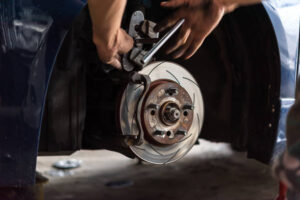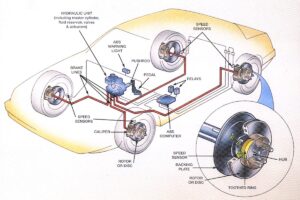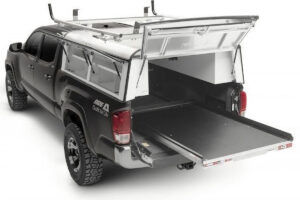
Ensuring Safe Braking: A Guide to Brake Preventive Maintenance
A Guide to Brake
Home » How Heavier Wheels and Tires Impact Braking Distance
But before we get into the details, here’s a quick summary: When you replace your factory wheels and tires with a set of aftermarket wheels and tires that are bigger and heavier, your vehicle won’t stop as well.
We estimate that a 10% increase in overall wheel size works out to a 10% decrease in brake performance. We have also estimated that a 10lbs increase in wheel and/or tire weight works out to a 1% decrease in brake performance. We call this the 10-10-10-1 rule of thumb.
If you increase the weight/mass of your wheels and tires, your brake system won’t work as well. If you’re a physicist or engineer, you can think about angular momentum and how it’s impacted by increased mass at an increased radius.
But if you’re not an engineer or physicist, there’s an easy way to think about wheel weight and braking. Imagine that your wheel and tire combination is a dog, and that the dog is running at you full speed. Would you rather stand in front of this 30lbs dog running at you full speed (photo dog1.jpg) ?
 This dog weighs about as much as most OEM alloy wheels.
This dog weighs about as much as most OEM alloy wheels.
Or stand in front of this 120lbs dog coming at you full speed (photo dog2.jpg) ?
 This dog weighs about as much as a pair of aftermarket wheels and tires.
This dog weighs about as much as a pair of aftermarket wheels and tires.
The point? The heavier a wheel is, the harder it is to stop it (or start it, for that matter). And when we’re talking about wheels and tires barreling down the highway at 75mph, a slight increase in overall weight can have a profound impact on brake system performance.
The bigger and/or heavier a wheel is, the harder it is to spin. Once it’s spinning, the harder it is to stop. Mathematically, the relationship between brake force (torque applied on the rotating axle) and wheel diameter and/or weight is roughly proportional.
Of course, there are a lot of factors here, but the relationship between brake force (torque), wheel size, and rotating mass is linear.
tl;dr; The bigger and heavier your wheels are, the worse your brakes will work.

As our math shows, a 10% increase in the radius of a wheel will reduce brake system performance by an equal amount. If, for example, you have a Jeep Wrangler with a stock 17″ wheel wearing 245/75R17 tires, your overall wheel radius is 15.7″ inches. Upgrading to a wider 17″ wheel with 315/70R17 tires will increase the overall radius to 17.2″ inches, which is just about 10% greater than stock.
So, if you’re considering a wheel and tire upgrade, it’s a good idea to calculate the overall diameter of the wheels and tires you’re looking at with the OE wheels and tires. If the radius is 10% bigger, stopping distances will increase by roughly the same amount.
Since the torque needed to stop your wheels is proportional to inertia, a 10% increase in the rotating mass of your vehicle will decrease brake system performance by the same amount. But defining rotating mass isn’t easy.
Rotating mass is hard to define because all the parts parts of your vehicle that are rotating when you drive down the road – the driveshaft, axle shafts, rotors, wheels, tires, and miscellaneous parts – are “rotating mass.” In order to figure out the inertia of all of these parts, you need to know both:
All the parts that rotate on your vehicle have inertia. When you increase the weight of any of those rotating parts, you increase the amount of force it takes to stop your vehicle.
Obviously, calculating the rotating mass/inertia of your vehicle is very difficult. And because every vehicle is different – with different size axle shafts, rotors, driveshafts, etc. – rotating mass can vary quite a bit.
Suffice to say, rotating mass is higher on heavy duty vehicles. If you have an F-350, your vehicle has more rotating mass than a Miata. But there’s no hard-and-fast rule here. If you double the weight of your wheels and tires, you’re going to make your brake system less effective.
Most drag racers find that a 10 lbs increase in wheel weight costs them about a tenth of a second in a quarter mile. This works out to about 1% more stopping distance per extra 10 lbs of weight at your wheels.
So, with the understanding that this is a very rough estimate, you can assume that every 10lbs you add in wheel/tire weight increases stopping distance 1%. Maybe more, maybe less – depends on the vehicle.
If you’ve installed a set of wheels and tires on your vehicle that are bigger and/or heavier than stock, there are a few things you can try to improve your brake system performance:
Replace your brake pads with a set of pads specifically designed to stop oversized wheels and tires.
If you’re trying to estimate the impact that a set of new wheels and tires will have on your brake system, follow our 10-10-10-1 rule of thumb.
If a wheel is 8% bigger than stock and weighs 40lbs more than stock, it will reduce brake system performance about 12%:
Basically, bigger wheels are bad for your brakes, but big and heavy wheels are really bad for your brakes.
A 10% increase in wheel size works out to a 10% decrease in brake system performance. A 10lbs wheel/tire weight increase works out to about a 1% decrease in brake system performance.
While our 10%/1% brake system rule of thumb is only an estimate, a quick search on Google or Bing shows that many consumers report poor brake system performance after installing new wheels and tires. If you’re looking for a quick and easy way to estimate brake system performance impacts, our 10-10-10-1 rule is a good place to start.
NOTE: If you have a set of oversized wheels and tires, be sure to check out our products. We’ve designed our products for vehicles with big wheels and tires.


